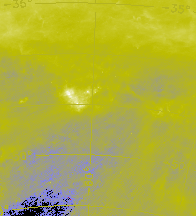RXTE Discoveries
Transient Pulsars in the Small Magellanic Cloud - March 1998
|
In November 1997, RXTE embarked on a series of observations that ultimately revealed five transient pulsars in the Small Magellanic Cloud (SMC). It started on the 24th of November, when RXTE was moved from one scheduled target to the next, what is known as a slew. During this maneuver, the X-ray detectors remained on and appeared to detect the transient source SMC X-3 which had not been seen since its discovery in the 1970's. After being notified of this by Dr. Frank Marshall, Drs. Jim Lochner, and Laura Whitlock (both of Goddard Space Flight Center) activated their Target of Opportunity proposal to observe transient sources (those that temporarily burst X-rays) in the SMC, and a series of observations ensued.
|
|
 |
Lochner and Whitlock had submitted their proposal to RXTE after they examined the data of this region from the Vela 5B satellite. From the Vela 5B data, they confirmed that the elusive sources SMC X-2 and SMC X-3 had not had any other outbursts between 1969 and 1976 (they were not even discovered until they burst for the first time in record in 1977). However, from the Vela 5B data, Whitlock and Lochner did discover an outburst of another nearby source, H0107-750. They wrote a proposal for RXTE to observe SMC X-2, SMC X-3, and H0107-750 or any of three other transient sources in the SMC should any of them undergo an outburst.
|
These particular sources were chosen because they are Be/neutron star systems. A Be/neutron system is a binary star system in which a B star (very hot and bluish-white) orbits a neutron star in a highly elliptical orbit. Every once in a while, the Be star ejects matter from its equatorial region. When the matter hits the neutron star, it produces X-rays. Because the Be star does not emit matter constantly, these outbursts of X-rays are short-lived, or transient events. Which means in order to detect them, you must be looking at them when they are outbursting.
|
On November 24, 1997, Dr. Frank Marshall, also of Goddard, told Drs. Lochner and Whitlock that RXTE had scanned across the SMC X-3 region and that it was outbursting! They did a follow-up observation, pointing RXTE's Proportional Counter Array (PCA) at the SMC X-3 region. Something was indeed happening! The data showed that there might actually be two pulsations present! One pulsation had a 46 second period while the other had a 91 second period. Two pulsations in a single system would be highly unusual, so they must belong to two different sources! The next step was to find out if either of these sources corresponded to SMC X-3.
|
 SMC X-3 Region |
RXTE isn't an imaging mission, meaning the data it collects tells us about the energy of the X-ray photons coming from a certain region of the sky, but it cannot resolve the photons to tell us precisely where they are coming from. RXTE is better at measuring the intensity of photons coming from a source and what their energies are. We call these light curves and spectra, respectively. By scanning across a portion of the sky, RXTE can determine the location of an object, but only to 0.1 degrees. When we want to know the precise location of a particular source, we have to have a satellite like ASCA, ROSAT, or BeppoSAX look at it.
In December of 1997, ASCA observed the SMC X-3 region. It found that SMC X-3 was not in outburst, But instead, two sources very near it were! With the 91 s and 46 s pulsars identified, Drs. Lochner and Whitlock decided to monitor them every three days to try to determine how quickly their intensity would decrease, and to see if there was evidence of orbital modulation of their periods.
On December 17 came another surprise. A new pulsar with a period of 169 seconds appeared! So now there were three sources near to the silent SMC X-3. Lochner and Marshall requested that the satellite BeppoSAX be used to image the region to determine the location of this new 169 s period source. (By this time, ASCA could not view it because of its sun constraints.) But before BeppoSAX could observe it, Dr. Lochner found, in the process of analyzing RXTE data, yet another pulsar, this one with a period of 59 seconds! Dr. Lochner didn't believe it at first, and not trusting its accuracy, redid his data analysis. But he was correct the first time. Says Dr. Lochner, "I really did it right, and there really was a 59 second period [pulsar]. There was no denying it."

To top it off, the 169 second period pulsar suddenly disappeared. BeppoSAX was, however, able to confirm the 59 second period pulsar. The 169 second period pulsar never reappeared and remains somewhat of a mystery because it was such a short-lived event. The 59 second pulsar did not start to fade until mid-February 1998 and was no longer visible by late February.
In going back over the very first observation made of this area of the sky, another pulsar popped out, this one with a period of 74 seconds. However, it did not appear in any of the successive observations that were made.
Luckily, an International Astronomical Union (IAU) circular describing an ASCA observation of the SMC X-3 area was brought to their attention. It showed that about two weeks before Drs. Lochner and Whitlock's first RXTE observation was made, the 74 second pulsar was visible, confirming that it did indeed exist.
What is so amazing about the discovery of these pulsars is that so many of them appeared in such a short time in such a small area of the sky - a rare occurrance. Dr Lochner adds, "When it comes to trying to explain why these five transient sources would all go off within the span of four months, it leaves me speechless!"



